Definition: McKinsey 7s model can be termed as an internal assessment tool for business organizations. It determines the organizational effectiveness by examining the alignment of the seven essential elements (i.e., hard elements – systems, strategy, structure; and soft elements – share values, staff, style, skills) with the core values of the entity.
Robert Waterman, Richard Pascale and Tom Peters introduced the concept of 7s framework in the year 1970. They were employed as consultants in McKinsey Consulting firm at that time. Thus, the tool was named McKinsey 7s model.
Content: McKinsey 7s Model
Elements of McKinsey 7s Model
An organization comprises of different aspects, the functioning of which defines the organizational strengths or weaknesses.
Thus, this framework consists of seven such crucial factors. Moreover, these can be broadly bifurcated into the following two categories:
Hard Elements
The elements which can be easily recognized and treated by the management in case of any issues are known as hard elements. This model states the following three hard components of an organization:
Strategy
A strategy is a set of actions formulated by the management, keeping in view the long term organizational objectives.
The company must be prepared in advance to cope up with the market competition. The organizational strategies should be in synchronization with the company’s vision, goals, values and mission.
The McKinsey 7s model provides the following checklist for the alignment of organizational strategy:
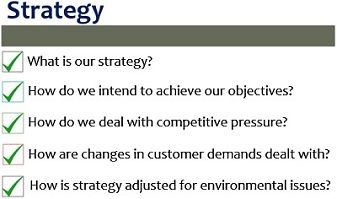
The above figure lists some questions whose answers must be known to the management.
It, therefore, explains the plan formulated and enlist the ways of attaining the organizational goals, handling the market competition, coping with changing consumer demands and dealing with the business environment problems.
Structure
The organization’s roles, responsibilities, authority and hierarchical arrangement determine its structure.
It defines the level of accountability and answerability of each personnel. It clearly states that who will report to whom, defining the superior-subordinate relations within the company.
The checklist for the organizational structure includes:

Thus, clarifying the team division, hierarchical structure, inter-department coordination, team arrangement or alignment, level of centralization and line of business communication.
Systems
The methods, procedures and process which forms the base of carrying out the routine business operations are termed as an organizational system. For instance, accepting only cash payment is a system in some organizations.
McKinsey model helps the management to set standards for regular decision making. Thus, it emphasizes on designing and establishing a robust system.
Given below is the checklist for this element:

Here, ascertainment of an organizational system in terms of security, human resource, finance and communication takes place.
Also, the control and evaluation mechanism of these systems, along with the internal tracking process is carried out.
Soft Elements
On the contrary, soft elements are complex and dynamic. These factors, usually define the organizational culture.
This model highlights the four essential soft elements which are explained in detail below:
Shared Values
This element can be entitled as the foundation of an entity. Shared values are the standards, principles, believes and norms set by the organization as guidelines for its people.
It is the core of any business, to better understand this element, go through its given checklist:
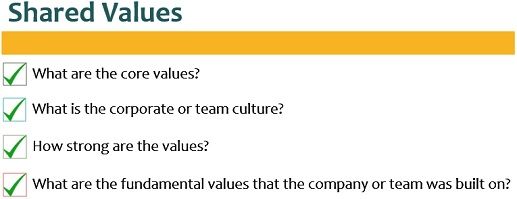
The answers to the above questions highlight an organization’s core values, corporate culture, the potential of the set values and fundamental or foundation values.
Style
In simple terms, style refers to how leadership and management of an organization are carried out to attain organizational goals.
The checklist comprises of the following questions:
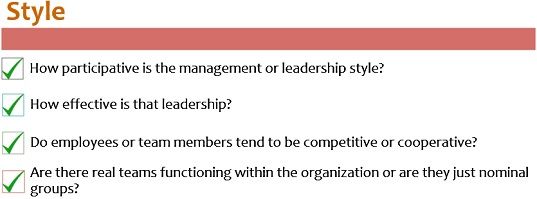
Here, we can find out the level of employee participation in decision making allowed by the management style.
Also, an organization’s leadership effectiveness, employees’ competencies and team efforts can be determined.
Staff
The composition of different personnel, engaged in carrying out various operations within the company, are unanimously called staff.
The organization essentially needs to place its personnel at the right positions to ensure optimal resource utilization.
The checklist under the McKinsey framework for this element is:
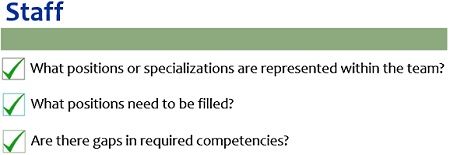
It brings into notice the team specialization, positions available within a team and areas of incompetencies.
Skills
The competencies or abilities of efficiently performing a particular task is termed as skills.
An organization has to find out the strengths and weaknesses of its personnel by adequately understanding their skills set.
Following checklist enlightens us on this element:
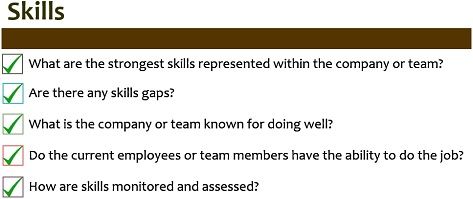
This factor analyzes the most active team skills, loopholes in the skills set, team strength, team abilities and ways to evaluate the personnel skills.
Application of McKinsey 7s Model
Is the McKinsey 7s model practically applicable? If yes, how can we use it in a real business situation?
Yes, this framework is beneficial when it comes to internal business. Let us see the step by step functioning of this tool:
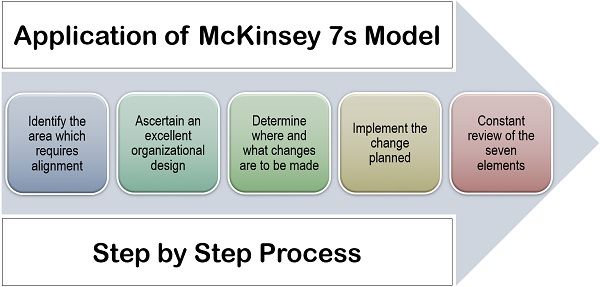
- Firstly, the management needs to find out the problem area, which requires the application of this model.
- The next step is to make sure that the organizational design is optimal. Also, through research and benchmarking, the level of alignment of the seven elements with this corporate design is ascertained.
- After analyzing the degree of alignment among the seven elements, the management has to outline the areas which demand change or needs to be reorganized; along with the kind of modification required.
- Next comes the successful implementation of the planned change with the help of experienced personnel, for acquiring effective outcomes.
- As we already know that these elements improvise from time to time, thus, they should be regularly assessed, to maintain the organizational efficiency.
Advantages of 7s Model
This model has been successfully applied by many known business entities to bring efficiency in their operations.
Let us now understand the various benefits of McKinsey 7s framework, which makes it a popular tool in the business world:
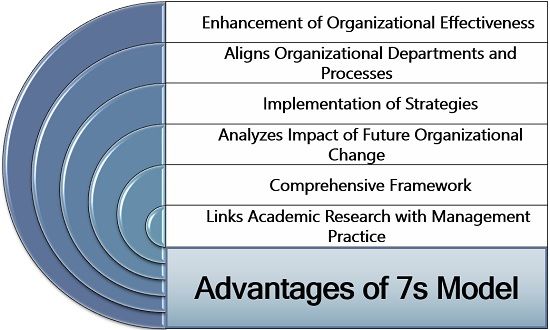
- When the essential components of the firm are aligned with its vision, the organization can achieve the desired objectives in a better way.
- It helps in bringing the various departments and processes in sync with each other, especially when mergers or acquisition takes place.
- It also facilitates the systematic application of the policies, regulations and strategies framed by the top management.
- The management can analyze the effects of changing corporate culture, policies, strategies, structure, technology over the organization.
- It is a broad approach since it inspects each of the seven elements and their correlation with each other.
- This model is not only theoretically developed but have been practically tested and applied for managing business organizations.
Disadvantages of 7s Model
The McKinsey 7s model is though helpful for the achievement of corporate goals; it consumes a lot of time and efforts of the managerial personnel, hampering the other activities.
There are certain other limitations of this approach, which are discussed below:
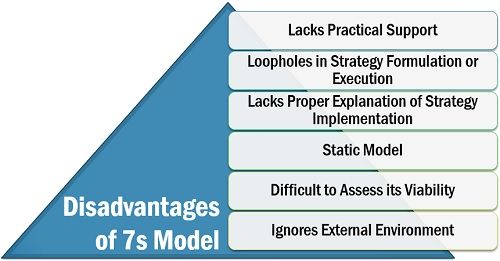
- The conclusion of the analysis sometimes does not have a proper factual backing.
- There are possibilities that the management may overlook some of the minute facts while framing or implementing the strategies.
- When it comes to the accomplishment of strategies, the analyst fails to explain such application clearly.
- It is a stagnant framework, especially in the short-term, since its result cannot be analyzed so soon.
- It is difficult to evaluate the degree of suitability of this model in a business organization.
- This framework emphasizes on the analysis of the organization’s internal factors, neglecting the external factors which substantially affect the business operations.
Conclusion
The McKinsey 7s model has positioned the shared values at the centre of the framework and the rest of the six elements around it.
This is because the 7s tool strongly believes that the organizational values hold significance in nurturing a business where all the other aspects are framed in alignment with this factor.
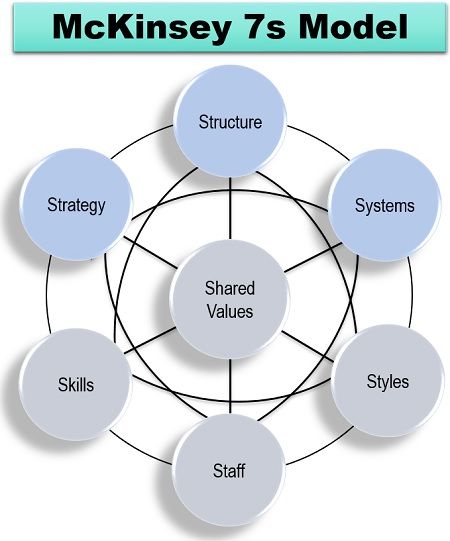
Nart Chantawong says
Practical and useful article
Brigete says
very practical in real business situation.